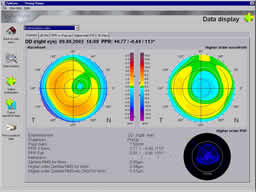Wavefront Guided Vision Correction
Wavefront Sensing & Customized LASIK
For more than 200 years, nearsightedness, farsightedness and astigmatism were the only optical errors of the visual system that could be measured and treated. Doctors and scientists always suspected that there were more imperfections, but we could not find them. In 1997, with the development of the wavefront sensor by Dr. David Williams' team at the University of Rochester’s Center for Visual Science, these so-called higher order aberrations could be identified. Instead of only measuring the lower order aberrations (nearsightedness, farsightedness and astigmatism), up to 64 different higher order aberrations were able to be quantified.
The team at Flaum Eye Institute Refractive Surgery Center, along with the scientists at the University of Rochester’s Center for Visual Science, took wavefront sensing to the next level and learned how to apply the data derived about a patient’s higher order aberrations to laser vision correction. Dr. MacRae and the Alliance for Vision Excellence—a team of physicians, scientists and researchers—continually collaborate and refine wavefront sensing and customized LASIK and PRK surgery to optimize visual results and increase the safety of surgery and satisfaction of our patients.
How Do Higher Order Aberrations Impact Vision?
Everyone has a certain degree of higher order aberrations in their visual system that may affect what they see. The University of Rochester determined that people with significant higher order aberrations may not see perfectly, even with the best glasses, contact lenses or refractive surgery possible. Two common and potentially disruptive higher order aberrations are Spherical Aberration and Coma. Spherical aberration creates halos around points of light while coma makes points of light appear comet-like with a blurry tail-like smudge to them.
Higher order aberrations are detected with a wavefront sensor. The genesis of this technology was originally developed in Dr. Williams’ laboratory. From there it spread across the vision correction industry. The technology works by sending a low power laser light into your eye and measuring the shape of the reflected wavefront of light. The wavefront sensor, like our Contora and iDesign systems, can analyze your lower and higher order aberrations in seconds, creating a perfect map of your unique optical imperfections.
Applying Wavefront Technology to Treatment
A wavefront display describes your basic prescription, your pupil size and provides a full analysis of your higher order aberrations. All patients evaluated for refractive surgery at Flaum Eye Institute Refractive Surgery Center are tested with wav efront sensing. Use of this technology enhances surgical results and safety.
efront sensing. Use of this technology enhances surgical results and safety.
When performing customized ablation we take data from the wavefront sensor and use it to program either of our excimer lasers. By treating both lower and higher order aberrations, Flaum Eye Institute consistently delivers unaided vision of 20/20 or better and — in many cases — unaided vision of 20/16 or better. Dr. MacRae and the Flaum Eye Institute Refractive Surgery Center team were the second group in the United States to use the wavefront sensing to create a customized ablation treatment and the first group to perform an independent FDA study with the technology.
Much of the custom laser vision correction technology used throughout the world was developed right here by Dr. MacRae. He and a team of optical scientists continue to refine and push the boundaries of wavefront vision correction to ensure the best results available.
Improvements in vision with customized ablation are in the quality of vision achieved, with patients noting improved sharpness particularly under low light conditions. Patients with significant levels of pre-operative higher order aberrations may be the best candidates for customized ablation.
Customized ablation may not be for everyone, but by utilizing this technology today, Dr. MacRae and the Flaum Eye Institute Refractive Surgery Center team can decide which type of refractive surgery is safest for you.